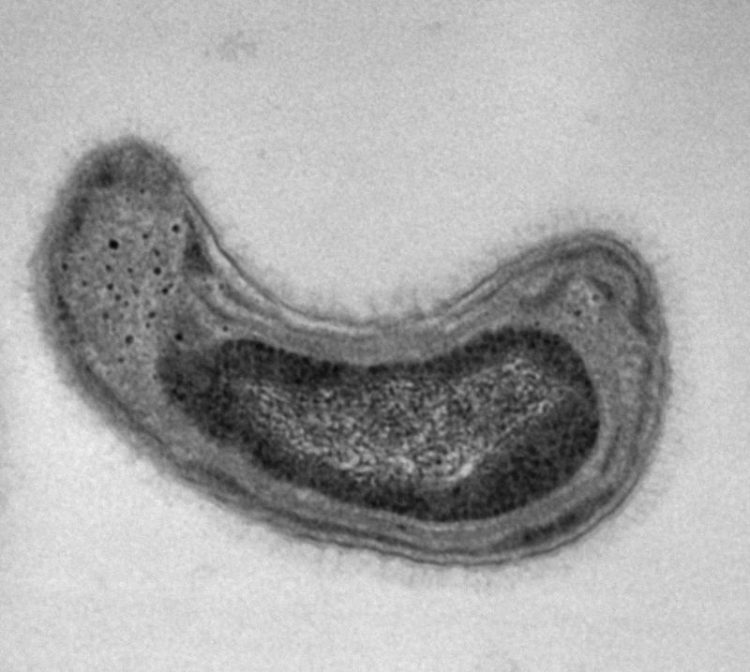Highly efficient agent against Wilson disease

Methylosinus trichosporium Source: Jeremy Semrau, University of Michigan
In Wilson disease, also called Wilson's disease or hepatolenticular degeneration, the body is no longer able to excrete excess copper ingested from food into the intestines via the bile. Instead, the copper is stored in the liver and other organs, where it can cause severe damage.
Doctors accordingly employ medicines called chelators that bind the surplus copper. These life-long treatments are especially effective if commenced during the early stages of the disease. The drugs must be taken several times a day, are repeatedly associated with undesired effects, and, particularly in the event of a late diagnosis of the disease, are often ineffective, so that a liver transplant can be necessary as the last resort.
Researchers headed by PD Dr. Hans Zischka, head of the Oxidative Cell Death research group at the Institute of Molecular Toxicology and Pharmacology at the Helmholtz Zentrum München have now conducted a detailed examination of a bacterial agent that could improve the disease treatment.
They looked to the bacterium Methylosinus trichosporium, which requires large quantities of copper due to its special methane metabolism. In order to acquire the necessary metal, it excretes the methanobactin molecule, which very efficiently binds copper.
Methanobactin as an improved treatment option in Wilson disease?
In order to check if methanobactin is also suitable for binding copper from the body, the researchers used an in vivo model for the disease that had the same genetic defect as that found in humans. “We were able to observe that even acute stages of Wilson disease reversed with methanobactin,” reports Josef Lichtmannegger, who, together with Christin Leitzinger, is the study's first author.
Further analyses showed that the improvement was due to a sharp decline in the copper quantities. Especially the mitochondria, known as the “powerhouse of the cell”, greatly profited from the dropping copper levels and were able to resume their full function. Methanobactin hindered the death of liver cells and prevented liver failure.
The researchers then compared methanobactin to chelators that are currently used in hospitals. Unlike the chelators, methanobactin was able to eliminate the copper overload in the liver cells within a few days, even in stages of severe damage, and prevent organ failure. The agent was also very well tolerated in the model.
“We hope that our work will make it possible to improve the treatment of Wilson disease and reduce the number of liver transplants,” states Zischka, the study leader. It is conceivable that in the long run it will be possible to replace the current use of less effective chelators several times a day with short treatment cycles using methanobactin. Clinical studies are now necessary to test this.
Further information:
Background:
Wilson disease is triggered by a hereditary defect in the so-called Wilson gene, which is why the disease is named after its discoverer. The Wilson gene codes for an ATP-driven copper transporter that moves the metal out of the liver cells. A mutation in the gene causes the copper to remain in the cells. Indications of liver damage range from a slight increase in the liver function tests to fatty liver to acute and life-threatening hepatitis or cirrhosis of the liver.
Original publication:
Lichtmannegger, J. et al. (2016). Methanobactin reverses acute liver failure in a rat model of Wilson Disease, Journal of Clinical Investigation, DOI: 10.1172/JCI85226
The Helmholtz Zentrum München, the German Research Center for Environmental Health, pursues the goal of developing personalized medical approaches for the prevention and therapy of major common diseases such as diabetes and lung diseases. To achieve this, it investigates the interaction of genetics, environmental factors and lifestyle. The Helmholtz Zentrum München is headquartered in Neuherberg in the north of Munich and has about 2,300 staff members. It is a member of the Helmholtz Association, a community of 18 scientific-technical and medical-biological research centers with a total of about 37,000 staff members. http://www.helmholtz-muenchen.de/en
Research at the Institute of Toxicology (TOXI) aims at understanding fundamental responses of the organism to chemicals. The goal is to better understand their mechanisms of action in the context of development or progression of chronic diseases. http://www.helmholtz-muenchen.de/en/toxi/index.html
Contact for the media:
Department of Communication, Helmholtz Zentrum München – German Research Center for Environmental Health, Ingolstädter Landstr. 1, 85764 Neuherberg – Tel. +49 89 3187 2238 – Fax: +49 89 3187 3324 – E-mail: presse@helmholtz-muenchen.de
Scientific Contact at Helmholtz Zentrum München:
PD. Dr. Hans Zischka, Helmholtz Zentrum München – German Research Center for Environmental Health, Institute of Toxicology, Ingolstädter Landstr. 1, 85764 Neuherberg – Tel. +49 89 3187 2663, E-mail: zischka@helmholtz-muenchen.de
Media Contact
All latest news from the category: Life Sciences and Chemistry
Articles and reports from the Life Sciences and chemistry area deal with applied and basic research into modern biology, chemistry and human medicine.
Valuable information can be found on a range of life sciences fields including bacteriology, biochemistry, bionics, bioinformatics, biophysics, biotechnology, genetics, geobotany, human biology, marine biology, microbiology, molecular biology, cellular biology, zoology, bioinorganic chemistry, microchemistry and environmental chemistry.
Newest articles

Silicon Carbide Innovation Alliance to drive industrial-scale semiconductor work
Known for its ability to withstand extreme environments and high voltages, silicon carbide (SiC) is a semiconducting material made up of silicon and carbon atoms arranged into crystals that is…

New SPECT/CT technique shows impressive biomarker identification
…offers increased access for prostate cancer patients. A novel SPECT/CT acquisition method can accurately detect radiopharmaceutical biodistribution in a convenient manner for prostate cancer patients, opening the door for more…

How 3D printers can give robots a soft touch
Soft skin coverings and touch sensors have emerged as a promising feature for robots that are both safer and more intuitive for human interaction, but they are expensive and difficult…





















